|
Contents
Membership Renewals
Expect to see Membership Renewal Invoices for 2021 which will be emailed on December 12, 2020. Be sure that you have included pal@memberclicks-mail.net in your contacts to ensure you receive the renewal notice as well as newsletters from the Ports-to-Plains Alliance. The Ports-to-Plains membership year runs through December 31st each year.
If you are not a current member of the Ports-to-Plains Alliance, membership information is available at: https://portstoplains.com/index.php/our-alliance/membership-information. Membership rates are available for Cities and Counties; Chambers of Commerce, Economic Development Organizations, College and University Memberships; Individuals; Business Investment; and State Trucking Associations. There is a link to requesting to join on the page linked above or you can contact Duffy Hinkle at 806-790-7196 or duffy.hinkle@portstoplains.com.
2020 has been a very successful year across the nine-state region as Ports-to-Plains continues its advocacy at federal and state levels. See the one-page summary of accomplishments below.
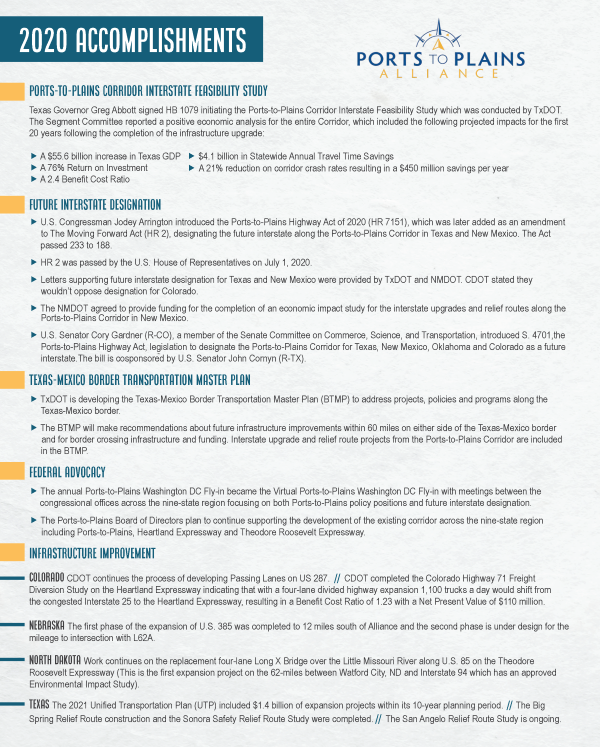
Link to Download PDF
Return to contents
Ports-to-Plains Alliance Reveals New Logo
After 23 years, the Ports-to-Plains Alliance has retired its historical logo. The new logo below carries over the concept of the compass from the historical logo, but in a newer, more modern setting.

Return to contents
San Angelo Rail Port Construction Set to Begin Before End of Year
The City of San Angelo Development Corporation has entered a public-private partnership with South Plains Lamesa Railroad (SPLRR) for the development of a multi-commodity railroad transloading facility, otherwise known as a rail port. The port will enhance the efficiency and profitability of industry in the Concho Valley by delivering bulk freight imports and exports to the United States and Mexico.
The facility will be located on a 180-acre tract east of Schwertner Road between FM 2105 and 50th Street. It will connect to the Texas Pacifico Transportation branch of the South Orient Rail Line, the portion of railroad that spans from Presidio, Mexico, up to San Angelo Junction in Coleman County.
The sale of the 180-acre site to SPLRR closed in October 2020. Construction will begin prior to the end of the year and initial operations should begin January 2021. SPLRR will oversee the design, construction and management of the rail port.
“The relationship built between the City of San Angelo and South Plains Lamesa Railroad will deliver a major economic development service to San Angelo and the Concho Valley,” said Michael Looney, vice president of economic development for the San Angelo Chamber of Commerce. “Rail freight will greatly reduce costs and increase the cargo transportation efficiencies of our many industries that will, in turn, create more economic prosperity for our city and region.
“The San Angelo Chamber of Commerce is very proud to partner with the City of San Angelo Development Corporation staff and board of directors on this historic industrial development.”
South Plains Lamesa Railroad, LTD. is uniquely qualified to develop, maintain and operate a multi-commodity bulk freight facility. Established in 1993, SPLRR owns and operates a rail port in Slaton, Texas that has expanded from an original five miles to now more than 23 miles of track. The company also operates a rail port facility at Pueblo, Colorado with 28 miles of track, providing industrial switching, rail car storage, rail car repairs and other switching services.
Texas Pacifico Transportation (TXPF) has endorsed the San Angelo Rail Port operation and entered into a services agreement with SPLRR. TXPF is a major partner in the development and success of the South Orient Rail Line (SORR), having just awarded a $14 million contract for rail improvement work. This was a significant step in the reopening of the rail freight corridor that connects freight movements between Texas and Mexico.
“The City of San Angelo Development Corporation (COSADC) is proud to be a partner in the development of the San Angelo Rail Port by securing the property for the project and entering into a performance agreement with SPLRR that will operate and eventually own the facility,” said Guy Andrews, COSADC economic development director.
“The impetus for the rail port came about by extensive investigation by our Chamber of Commerce partners lead by Michael Looney and consultant Rodger Horton of Shea Transportation Consulting into the feasibility and demand for such a facility.”
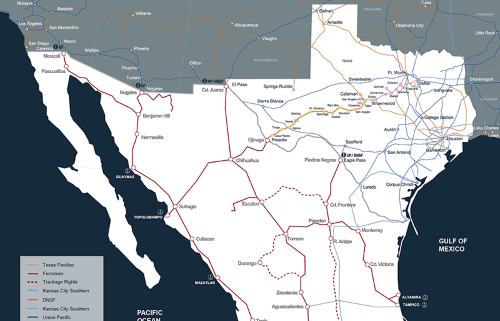
Return to contents
Opportunity for Construction Funding on North Dakota U.S. Highway 85 on the Theodore Roosevelt Expressway
North Dakota’s Governor Doug Burgum, provided his biennial 2021-2023 budget proposal on Thursday, December 3, 2020. In that presentation, he included a proposal for transportation that would benefit the next segment of U.S. Highway 85 on the Theodore Roosevelt Expressway.
In March 2019, the Record of Decision was signed for the Environmental Impact Statement (EIS) for U.S. Highway 85 between Watford City and Interstate 94 at Belfield. Approval of the EIS opened the ability to begin upgrading this 62-mile two-lane highway to a four-lane highway. The first construction project on the corridor was the replacement of the Long X Bridge over the Little Missouri River which was completed in October 2020.
The next segment proposed for upgrade to a four-lane highway is the 10.3-mile section connecting the existing four-lane highway south of Watford City to the Long X Bridge. North Dakota DOT’s estimated budget for the project is $104.5 million.
Governor Burgum proposed, as part of the budget, that North Dakota take advantage by funding major infrastructure projects with a $1.25 billion bonding package, backed by earnings from the state's Legacy Fund. Burgum outlines why it is the right-time for the State of North Dakota to do bonding. Listen to the 24-second clip to hear his reasoning.
Burgum Reasons for Bonding
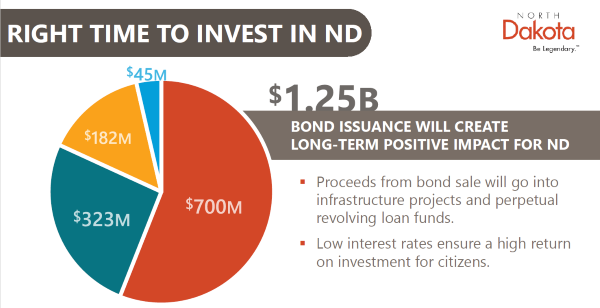
The Legacy Fund is a constitutional amendment approved by 67% of the North Dakota voters in 2010. It was designed to convert oil revenue, a finite resource, to cash and create a permanent fund for future generations. Burgum outlined five criteria for Legacy Investment. A portion of Legacy Fund earnings would be used to create a Legacy Bond Repayment Fund to make the debt payments on the $1.25 billion in bonds.
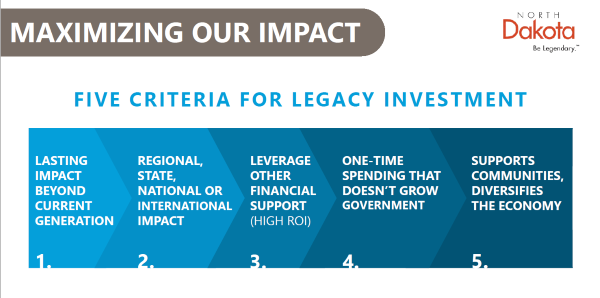
Included in the $1.25 billion bonding would be $325 million for infrastructure projects which would include the four-lane expansion of U.S. Highway 85 on the Theodore Roosevelt Expressway.
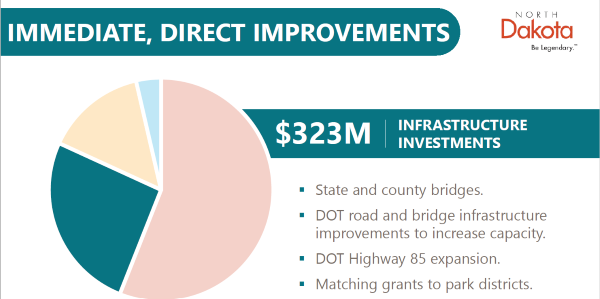
Return to contents
Corridor Interstate Feasibility Analysis and Findings
Source: Ports-to-Plains Corridor Interstate Feasibility Study
The next section of the Ports-to-Plains Interstate Feasibility Study compares the Interstate Upgrade to the 2050 Baseline.
The Baseline analysis assumes only currently planned and programmed projects are implemented along the Corridor by 2050. These planned and programmed projects are included in the 2020 Texas Unified Transportation Plan (UTP)
The Interstate Upgrade analysis assumes improvements to provide a continuous-flow, fully access-controlled facility with a minimum of two lanes in each direction separated by a median within a typical 300- to 500-foot right-of-way.
The Advisory Committee found that the Interstate Upgrade is essential.
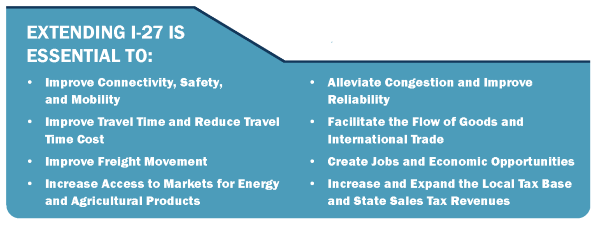
Safety Findings
In 2050, the Interstate Upgrade estimated crash rate reduction corridor-wide over the 2050 Baseline is 21%. Compared to the 2018 crash rate the reduction would be 41%.

Mobility Findings
The Interstate Upgrade would reduce corridor travel time in 2050 over the Baseline by 89 minutes. This is in addition to the Travel Time reduction of 20 minutes provided by the Baseline over the 2018 Travel Time. Total Travel Time Savings between 2018 and the 2050 Interstate Upgrade is 109 minutes.
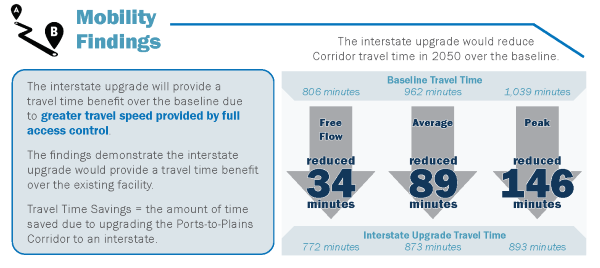
Freight Movement Findings
The Interstate Upgrade would attract truck traffic from nearby parallel routes, as well as national routes like I-10, I-35 from Laredo to San Antonio, and I-35 to I-70 from Dallas to Denver. Also provide improved access to international trade gateways of Del Rio, Eagle Pass and Laredo.
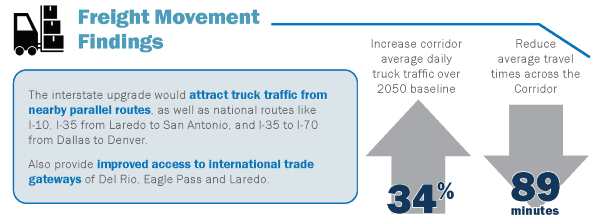
Energy and Agriculture Products to Market Findings
The reduction in travel time, safety, increased market access radius, and increase in route reliability provided by the Interstate Upgrade will help improve the movement of energy and agriculture energy industry products to market.
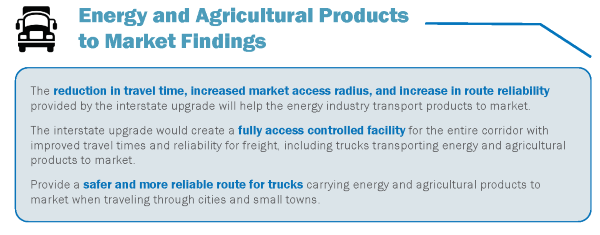
Link to Printable Feasibility Study Above (pdf)
Return to contents
Check out the newest Ports-to-Plains Video!
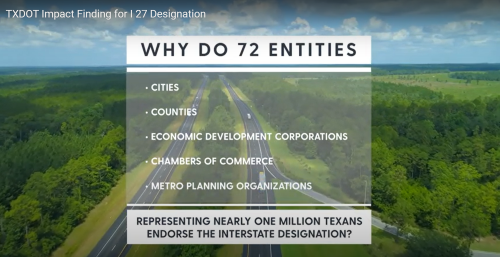
Click to View This Video
Return to contents
|